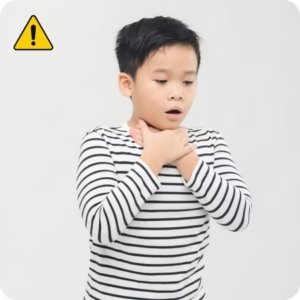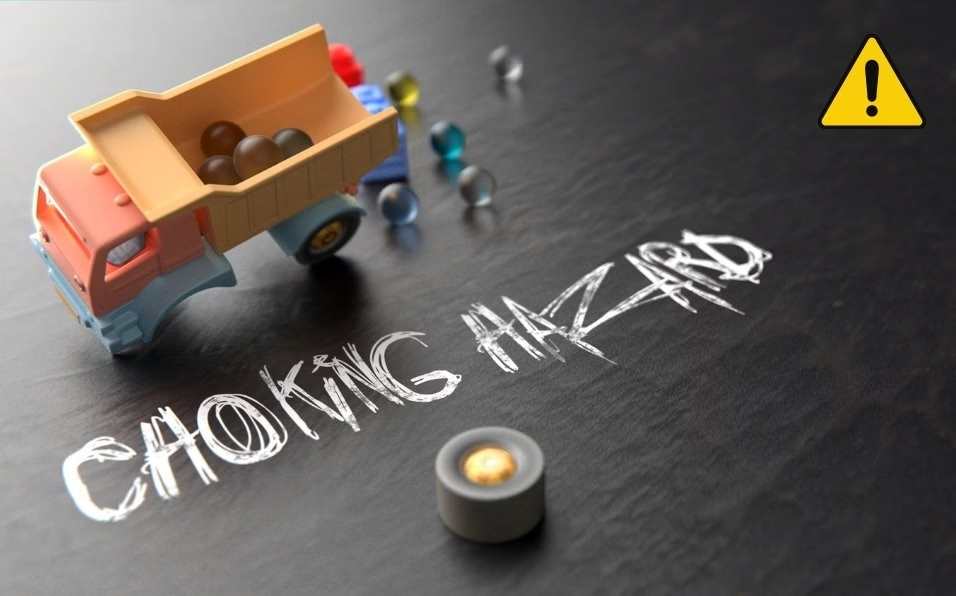Choking happens when something goes down your throat and blocks your airway. This can be really frightening, especially for little ones. This article will discuss choking hazards for kids—items that can cause kids to choke and how to remain safe.
Within this write-up
- What is a Choking Hazard for Children?
- How Does Choking Happen?
- Why Are Children More Prone to Choking?
- What Makes An Object a Choking Hazard to Kids?
- Choking Hazards for Kids: The Most Common Things Kids Choke On
- How Can We Avoid Choking Hazards for Children?
- Signs of Choking: What to Look For
- What to Do in Case of Choking
- Checklist of Preventing Choking Hazards for Kids
- Frequently Asked Questions (FAQs)
What is a Choking Hazard for Children?
Choking hazards for children are objects that can slip into a person’s airway, preventing that person from getting the volume of air they must take in to breathe. A foreign item in the throat might block airflow to the lungs. This is very dangerous. If it is not promptly repaired, it can block off and suffocate the individual.
How Does Choking Happen?
Choking happens when an object — most often food or a small object — gets swallowed or inhaled to the point of becoming stuck in the throat or windpipe. A person cannot breathe and air cannot flow into the lungs if the airway collapses. This could be very damaging and must be looked into immediately.
Why Are Children More Prone to Choking?
Kids are inquisitive, and they need to discover things through oral techniques. Some kids under the age of 4 have a tendency to pick up small objects and attempt to swallow them. They don’t always realize how dangerous this can be. This is why the choking hazards for kids are typically small, round, hard or slippery objects. These can inadvertently slip down the throat and become lodged.
Children also have smaller airways than adults do. A tiny piece of food or toy could appear safe to an adult but can obstruct a child’s windpipe. It can cause them to have difficulty, or inability, to breathe. That’s why you need to be extra careful with kids under 5. They’re more prone to choking.
What Makes An Object a Choking Hazard to Kids?
For an object to be deemed a choking hazard for children, it usually has to be met with certain criteria:
Size:
It should be small enough to fit into the child’s airway. In fact, most choking hazards for children are smaller than the width of a child’s windpipe. If an object fits in a toilet paper roll, it’s small enough to potentially be a choking hazard.
Shape:
The object can be round, smooth or hard, making it impossible to chew, swallow or digest. Ones that are round — rounds, like marbles or grapes — are particularly dangerous. They are very easy to get stuck in the throat. When they do, they can block the airway and hinder breathing.
Material:
Soft or squishy foods can also be a risk. This is especially true if they break into smaller pieces when chewed. Those small pieces can be easy to swallow whole. Hot dogs, popcorn or candy, can pose a serious risk for younger kids. If not chopped or prepared in a particular way, these foods pose a choking hazard.
Choking Hazards for Kids: The Most Common Things Kids Choke On
Examples of common choking hazards for children include:
Food:
Hot Dogs: Round and compact hot dogs pose a common choking threat for children.
Peanut Butter: Toddlers choke on it. It may also become stuck in their throat.
Nuts: Whole, i.e. peanuts, almonds, may be hard to chew and small enough to become lodged in the airway.
Popcorn: Popcorn kernels are extremely hard and can become stuck in the throat.
Hard candies: Lollipops or hard fruit-flavored candies can block the airway. They’re tough to chew and slow to melt down.
Cheese: Cheddar or mozzarella cheeses can be slimy and difficult to chew. They can cause choking if a child bites into them whole.
Grapes: These round, slippery fruits can easily go down a child’s throat, unless they are cut into small pieces.
Carrots: They are crunchy and they are coarse, so it is difficult for babies to chew it properly. If children bite off a big piece, it can lodge in their throat.
Apple Slices: Apples are crunchy and have a hard skin, which makes it hard for younger kids to chew them completely. But if the pieces are oversized, they can quickly turn into a choking hazard for kids.
Cherries: These are too small and round for their own good and can be swallowed whole. And the pit inside can be choking hazard for kids.
Marshmallows: Gooey and sticky marshmallows can easily grow to fill a child’s throat or block his airway.
Tomato Chunks: Raw tomatoes can be slippery and difficult for little ones to chew, particularly in big chunks.
Olives: Whole olives — especially large ones — can be slippery and round. This makes them a choking hazard for kids if not cut appropriately.
Canned Pineapple and Mango Chunks: Fresh pineapple and mango can be both hard and slippery. This makes them tricky to chew for younger kids.
Small Toys and Objects:
Common kids’ choking hazards include things like buttons, coins, marbles and small toy parts. These are small enough to be ingested and become stuck in the windpipe.
Household Items:
Many everyday objects can be choking hazards for kids if they’re not out of reach of children. Items such as balloons, small rubber bands and leftover parts of broken toys can be dangerous.
How Can We Avoid Choking Hazards for Children?
Supervision:
Always monitor children closely, especially during mealtime or when playing with small objects. It is very important to be close enough to intervene if needed.
Safe Food Preparation:
When you feed young kids, please cut them small. For example, slice grapes in half or quarters. Chop hot dogs into tiny pieces.
Safe Toys:
Choose toys for your child according to age. Look for small parts that might break off, and ensure the toy could not fit into the child’s mouth.
Childproofing:
Store small objects—coins, buttons and marbles—where children can’t reach them. Ensure that what children play with is too big to be swallowed.
Signs of Choking: What to Look For
If a child is choking, they might:
- Have trouble breathing.
- Be unable to cry or make sounds.
- Hold their throat or look scared.
And if this does occur, it’s urgent to act quickly. If the child is coughing or gagging, encourage them to cough in an attempt to clear their throat. If they can’t breathe, call for help immediately.
What to Do in Case of Choking
If a child is choking, here’s what to do:
- For children older than one year:
Perform five vigorous back slaps by striking the child’s back between the shoulder blades.
If that fails, you can administer the Heimlich maneuver to try to force the object out.
- For babies under one year:
Hold the baby face down on your arm and give five back blows.
If that fails, use chest thrusts to expel the object.
If you are not able to clear the airway, always call your local emergency number.
Checklist of Preventing Choking Hazards for Kids
Here’s a straightforward checklist to help protect your child:
- Ensure toys are sized correctly and developmentally appropriate.
- Cut food into small, safe pieces.
- Keep small items like coins and buttons out of reach.
- Never leave children unattended while eating or playing with small objects.
Choking hazards for the kiddos are very real, but with a few easy precautions, we can hopefully keep all of our littles as safe as we can. Never leave them unattended, select safe toys and cut food into safe sizes. These procedures can reduce the danger of choking and protect your kid.
Frequently Asked Questions (FAQs)
What to do if my child swallows a coin?
If your child ingests something small, which takes a few minutes to do, you should immediately call a doctor. Don’t attempt to make them vomit or administer anything to drink.
Can babies choke on liquids?
Babies can also choke on liquids, especially if they are drinking too rapidly or if they’re lying down. Be sure that they are always sitting up to drink.
Affiliate Disclaimer: kidsallitems.com is a participant in the Amazon Associate Program, which means we will earn a small commission if any customer makes any purchase through our Amazon Affiliate Links, with no additional cost to the customer. As an Amazon Associate, our website earns from qualifying purchases.
Price information on this website is current but subject to change. We keep the information current, but Amazon prices, availability, and other details may fluctuate. For current pricing and information, please check the Amazon product page provided at the affiliate link.



